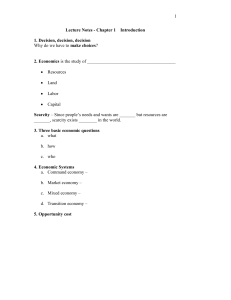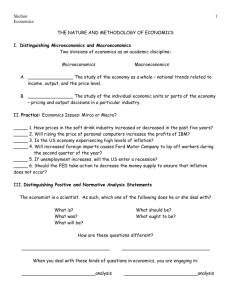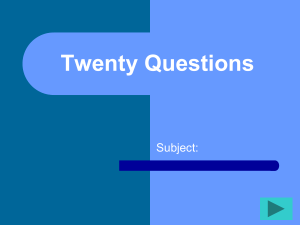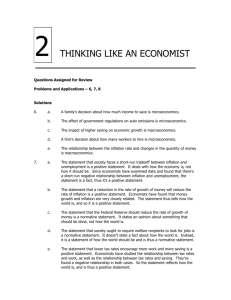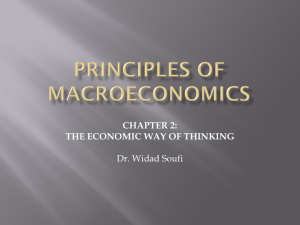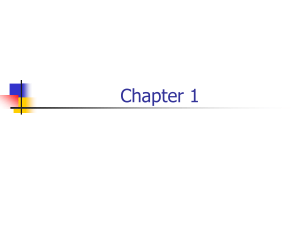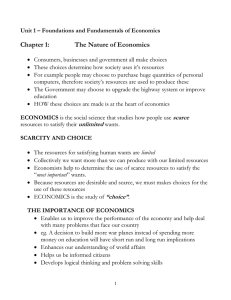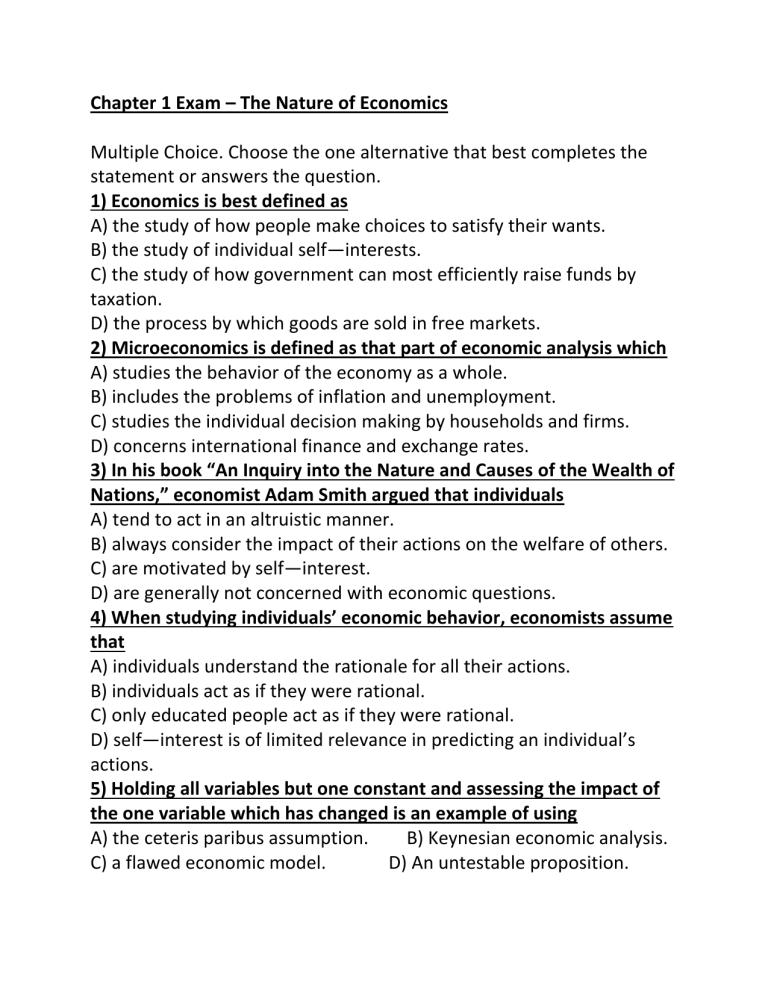
Chapter 1 Exam – The Nature of Economics Multiple Choice. Choose the one alternative that best completes the statement or answers the question. 1) Economics is best defined as A) the study of how people make choices to satisfy their wants. B) the study of individual self—interests. C) the study of how government can most efficiently raise funds by taxation. D) the process by which goods are sold in free markets. 2) Microeconomics is defined as that part of economic analysis which A) studies the behavior of the economy as a whole. B) includes the problems of inflation and unemployment. C) studies the individual decision making by households and firms. D) concerns international finance and exchange rates. 3) In his book “An Inquiry into the Nature and Causes of the Wealth of Nations,” economist Adam Smith argued that individuals A) tend to act in an altruistic manner. B) always consider the impact of their actions on the welfare of others. C) are motivated by self—interest. D) are generally not concerned with economic questions. 4) When studying individuals’ economic behavior, economists assume that A) individuals understand the rationale for all their actions. B) individuals act as if they were rational. C) only educated people act as if they were rational. D) self—interest is of limited relevance in predicting an individual’s actions. 5) Holding all variables but one constant and assessing the impact of the one variable which has changed is an example of using A) the ceteris paribus assumption. B) Keynesian economic analysis. C) a flawed economic model. D) An untestable proposition. 6) A microeconomist would study all of the following issues except A) the impact of a change in consumer income on the sales of corn. B) the impact of a snowstorm on the sales of snow shovels. C) the most efficient means for General Motors to produce an automobile. D) the effect of a change in income taxes on the nation’s rate of unemployment. 7) An appropriate test of the effectiveness of an economic model is A) the number of variables contained within the model. B) the model’s ability to predict future activity. C) the number of economists who have worked on the model. D) the number of assumptions which the economist has made. 8) “if A occurs then B will follow” is a A)positive statement. B) normative statement. C)non—testable statement. D) statement lacking in logic. 9) Normative economic statements A) violate the law of ceteris paribus. B) contain value judgments. C) are usually irrational. D) are easily testable. 10) “No individual should have less than $10,000 income in the United States in 1990” is an example of A) a normative statement. B) a positive statement. C) an illogical and refutable statement.D) a truism. 11)Which of the following is a normative statement? A) An increase in consumer income will lead to increased sales of beef. B) A decrease in the rate of unemployment will lead to upward pressure on consumer prices. C) An increase in the income tax will cause a greater reduction in savings than an increase in the sales tax. D) An economy with high unemployment is worse than an economy with high inflation. 12) Which of the following is a positive economic statement? A) No individual should live in poverty. B) The rate of unemployment of young African-Americans exceeds that of white Americans. C) Unemployment is a more serious problem than inflation. D) Economic considerations are less relevant than other more ethical issues in deciding national policy. 13) One reason why economists often use models in their analysis is that A) a model helps us to understand, explain, and predict economic phenomena in the real world. B) a model accurately pictures every detail of the real world economy. C) a model relates to individual thought processes rather than behavior. D) it is relatively easy to perfectly specify a model. 14) The macroeconomist would most likely study A) the effects of changing apple prices on the market for oranges. B) the effects of an increase in wage rates on a woman’s decision to enter the labor force. C) the effects of a reduction in income tax rates on the nation’s output. D) the effect of increased union wages on the cost of producing automobiles. 15) Macroeconomics is the study of economics from the standpoint of A) a specific individual. B) a typical firm. C) a typical household. D) the economy as a whole. 16) Microeconomics is the study of A) the behavior of the economy as a whole. B) how rising prices affect the level of employment in the economy. C) how individuals and firms make decisions. D) the effect that money has in the economic system. 17) Macroeconomics is best defined by which of the following statements? A) Macroeconomics is the study of how firms strive to maximize their profits. B) Macroeconomics is the study of the behavior of the economy as a whole. C) Macroeconomics is the study of individual economic units. D) Macroeconomics is the study of how the prices of individual goods are determined. 18) When a U.S. Senator tells a campaign crowd that “High inflation rates are a much more serious economic problem than high unemployment rates,” it is an example of A) a normative statement. B) an empirically proven fact. C) a positive statement. D) a microeconomic argument. 19) Select the positive economic statement from the following list. A) The number of families living in poverty in the United States is too high. B) One in every five children in the United States is living in poverty. C) Government programs to help the poor are just making the problems worse. D) Increases in poverty rates signify a deterioration of the U.S. economy. 20) Which of the following statements is a statement of normative as opposed to positive economics? A) Consumer spending generates more jobs. B) If the price of gasoline goes up, people buy less. C) Labor unions should be allowed to organize in every industry. D) Government intervention in markets is common in many countries. 21) Which statement most accurately defines economics? A) Economics is the study of how people make money. B) Economics is the study of how people make choices to satisfy their wants. C) Economics is the study of values a society should choose. D) Economics is the study of how to eliminate scarcity. 22) In economics, the concept that individuals are motivated by self interest and respond predictably to opportunities for gain is known as A) rational self—interest. B) altruism. C) sufficiency. D) empiricism. 23) The term “ceteris paribus” means A) the greatest good for all. B) the study of scarcity and choice. C) all other things remaining constant or equal. D) value free and testable. 24) Which of the following is an example of an application of the “ceteris paribus” assumption? A) An analysis of how price changes affect how much people will purchase when all other factors are held constant. B) An analysis of how people purchase more goods when prices decline and income increases. C) After reading an article on the dangers of high fat diets, an individual buys less red meat when prices increase. D) An analysis of how worker productivity increases when a firm invests in new machines and training programs. 25) Which of the following statements is FALSE? A) Economists empirically test their models. B) The usefulness of an economic model does not depend on how well the model predicts. C) An economic model should capture only the essential relationships that are sufficient to analyze the particular problem being studied. D) Economic models relate to behavior rather than to individual thought processes. 26) Which of the following statements about economic models is true? A) Economic models are not empirically testable. B) The predictive power of models is not important. C) Economic models are designed so that every detail of the real world can be analyzed. D) Every economic model is based on a set of assumptions. 27) Whenever statements embodying values are made, we enter the realm of A) positive economics. B) normative economics. C) microeconomics. D) macroeconomics. 28) In economic analysis, peoples resources are A) limited, and their wants are unlimited. B) unlimited, and their wants are also unlimited. C) limited, and their wants are also limited. D) unlimited, and their wants are limited. 29) In economics, all the things that people would consume if they had unlimited income are known as A) wants. B) aggregates. C) outputs.D) needs. 30) One topic of study for a microeconomist would be A) the causes of inflation. B) the causes of aggregate unemployment. C) the effects of an increase in the price of gasoline. D) the effects of an increase in government spending. 31) Macroeconomics is concerned with A) individual consumers. B) government decision-making concerning farm price supports. C) aggregates. D) the effects on a corporation of a strike by the United Auto Workers. 32) Macroeconomics often relies on microeconomic analysis because A) microeconomics is older than macroeconomics. B) microeconomic theory can be tested and macroeconomic theory cannot be tested. C) all aggregates are made up of individuals and firms. D) the effects of macroeconomic subjects such as inflation and unemployment are independent of individual consumers and firms. 33) Economists assume that people are motivated by A) benevolence. B) altruism. C) greed. D) self—interest. 34) Economists assume people behave rationally, which means that people A) never make a mistake. B) do not intentionally make decisions that make themselves worse off. C) have the necessary information to always make correct decisions. D) always understand the consequences of their decisions. 35) Another term for economic models is A) economic designs. B) economic theories. C) economic science. D) economic maps. 36) A simplified representation of the real world that is used to explain economic phenomena is a(n) A) map. B) model. C) assumption. D) implication. 37) A good economic model A) utilizes only the two most factors to analyze the problem under consideration. B) generates statements that are incapable of refutation. C) represents every detail of the real world. D) yields usable predictions and implications for the real world. 38) A map is an example of a model because a map A) realistically describes an area. B) is always as complex as space will permit. C) is two-dimensional. D) is a simplified representation about reality. 39) ‘Ceteris paribus” means A) making all the necessary changes. B) other things constant. C) for certain parameters. D) let the buyer beware. 40) The assumption that “other things are constant is also known as the A) ceteris paribus assumption. B) rational self—interest assumption. C) distinguishing characteristic of economics as a science. D) relationships assumption. 41) The usefulness of a model is determined by A) whether it yields usable predictions for the real world. B) whether it possesses realistic assumptions. C) how well it uses the ceteris paribus assumption. D) how many of the possible relationships that exist are included 42) Economics is an empirical science, which means that economists A) have to use laboratory experiments, at least some of the time. B) evaluate a model or theory by whether its assumptions are consistent with the real world. C) try to prove their models are true by referring to logic. D) look for evidence to whether the model is useful or not. 43) If two competing models are offered to explain a certain economic phenomenon, the better model is the one A) that is the newest since newer models are better than old models. B) with the fewest unrealistic assumptions. C) that consistently predicts the most accurately. D) that is not subject to empirical verification. 44) To be useful, a model must A) predict accurately all of the time. B) predict more accurately than other models that have been developed. C) have assumptions that have been verified by empirical testing. D) explain and predict the behavior of every individual. 45) Positive economic analysis is said to be A) true. B) right. C) value—laden. D) value—free. 46) Normative economic analysis involves A) positive analysis. B) value judgments. C) if—then statements. D) objective descriptions of the way things are. 47) Which of the following statements is an example of positive economic analysis? A) The inflation rate is too high. B) The government should worry less about inflation and more about unemployment. C) If the government increases the rate of growth of the money supply, the inflation rate will increase. D) Since the elderly live on a fixed income, the government has an obligation to keep inflation rates low. 48) Which of the following is a normative economic statement? A) An increase in the corporate income tax will cause the unemployment rate to increase. B) The costs of medical care are increasing faster than the incomes of American citizens. C) Teenage unemployment is over ten percent. D) Teenage unemployment is too high. 49) Which of the following is an example of a normative economic statement? A) Lower income tax rates will generate greater income tax revenue to the government. B) Income tax rates should be lower because that will increase government revenue. C) Lower income tax rates yield a larger federal government deficit. D) The federal budget deficit has increased every year for the last twenty years. 50) Which of the following statements concerning the distinction between positive and normative economics is true? A) Positive statements are concerned with what is while normative statements are concerned with that someone thinks should be. B) Positive statements are concerned with what people think, while normative statements are concerned with what people do. C) Positive statements are true while normative statements are false. D) Positive statements are concerned with what is while normative statements are concerned with what will be. 51) Economics is called an empirical science because A) economists study evidence to test their models. B) economists use assumptions in their models. C) economic models have no predictive power. D) economic analysis is only useful in a capitalistic society. 52) In economics, things that are used to produce goods and services are known as A) wants. B) aggregates. C) factors of need. D) resources. 53) The potential rewards that are available to an individual if a particular activity is undertaken are known as A) premiums. B) gifts. C) incentives. D) intrinsic values.
